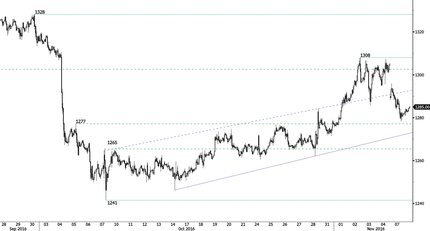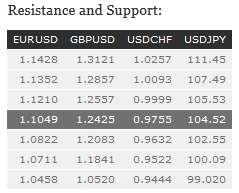Forex News and Events
Election Day
All we can say is…finally. After unofficially being the longest US presidential election campaign the voting booths are now open. Markets are now expecting Clinton’s ascension to the White House with risk appetite higher across the board. Swissquote’s online predictive analytic tool now puts Clinton at 46.7% and Trump at 44.5%, a slightly wider margin then Monday. Nate Silvers FiveThirtyEight’s forecast estimates Clinton’s chance of winning at 71%.
With Clinton holding a solid 266 electoral college votes she will only need 4 leaning or battleground states to shift in her favor to become the first female American president. Despite much of a Clinton victory already being priced in, we are still expecting a market relief rally. We should see further improvement in global equity markets, EM currencies (specifically MXN, KRW and CNY) and selling in gold, JPY and CHF. Yet, we caution traders from entrenching themselves in “normal” narrative. We highly doubt that this will be a linear event, with votes tallied, concession speeches made and inaugurations planned. This is not a singular Brexit vote but a test in dynamic analysis. In the past the election could be “called” as early at 04:00 CET, but more recently many days later. For an early call to occur, most battleground states on the east coast (especially Florida, Penn and Ohio) must go for Clinton by a wide margin. In this case the media will call the election and the loser will have to delineate a Plan B (we believe Trump has already “lawyered up” and is ready for a fight). Even should Clinton sweep key battleground states it is unlikely that Trump will concede, making the prospect for further volatility in the next few days. We continue to see demand in option tails indicating that traders are playing way out of the money scenarios.
SNB Dilemma
Along with many international officials, the SNB also breathed a sigh of relief with the lower possibility of a Trump Presidency. SNB board member Andrea Maechler stated that the central banks were ready to intervene in foreign exchange makers to weaken the CHF. The CHF has become increasingly correlated to Trump polls, indicating a victory would likely trigger further safe haven demand. Last week’s collapse of Clinton in national opinion polls saw the USD/CHF fall to its lowest levels since June. Swiss foreign reserves suggest that the SNB has intermittently intervened to stem the pace of CHF appreciation, although intervention seems to have trailed off recently. This week consumer price data indicates that inflation pressures remains weak, falling -0.2% y/y in October (following an equally weak September). The strong CHF continues to import deflation, negating the SNB's efforts to reach its target level. Yet, policy mixes such as negative interest rates and FX intervention have not shown significant efficiency. With the long term negative effect on savers, banks and insurance companies weighing on decisions, it remains unclear how long the SNB can maintain its current monetary policy stance. We remain constructive on the CHF in the mid and long-term (short term election driven selling on a Clinton victory).
China: Exports tumble despite weaker yuan
China’s economy is facing difficult moments. Last night, exports collapsed to -7.3% y/y representing the seventh consecutive month of decline. Overall, global demand is on the soft side and it is clear that the Chinese economy is well into a shifting process from international to domestic growth.
The weaker yuan has not brought sufficient fuel to spur exports. The Chinese currency has nonetheless lost 1.5% in October against the dollar and 9% since last year. The country’s imports fell 1.4% amid weakening demand, nonetheless driven by an increased call for commodities. As a result, the trade surplus fell to $49.1 billion for October which is still largely positive. In our view, this trend is likely to continue. One indictor which we closely monitor is the Baltic Dry Index which represents the cost of freight. This index is still at a very low level (870) compared to levels reached in the first decade of this century (between 2500 and 10000). The slight pick-up in the index is not sufficient to justify a global recovery.
Moreover, as consumer and producer prices rise at a quicker than expected pace, this tends to offset the lower currency. We believe that sooner than later China will export inflation. This is why in our view, we maintain our bullish view on commodities despite an already announced December rate hike, which should be the only one for at least a year.


The Risk Today
EUR/USD is weakening. Hourly resistance is given at 1.1145 (06/11/2016 high) while key resistance is located far away at 1.1352 (18/08/2016 high). The short-term technical structure suggests further strengthening. In the longer term, the death cross indicates a further bearish bias despite the pair has increased since last December. Key resistance holds at 1.1714 (24/08/2015 high). Strong support is given at 1.0458 (16/03/2015 low).
GBP/USD is pausing above 1.2400. Hourly resistance is given at 1.2557 (04/11/2016 high) while hourly support is given at 1.2083 (25/10/2016 low). Yet, strong resistance stands far away at 1.2620 then 1.2873 (03/10/2016). Expected to further monitor 1.2400 before entering another decline. The long-term technical pattern is even more negative since the Brexit vote has paved the way for further decline. Long-term support given at 1.0520 (01/03/85) represents a decent target. Long-term resistance is given at 1.5018 (24/06/2015) and would indicate a long-term reversal in the negative trend. Yet, it is very unlikely at the moment.
USD/JPY has finished its reversed move from hourly support lies at 102.55 (03/11/2016 low). Hourly resistance is given at 104.62 (07/11/2016 high) and 105.53 (28/10/2016 high). Key support can be found at 100.09 (27/09/2016). Expected to further decline. We favor a long-term bearish bias. Support is now given at 96.57 (10/08/2013 low). A gradual rise towards the major resistance at 135.15 (01/02/2002 high) seems absolutely unlikely. Expected to decline further support at 93.79 (13/06/2013 low).
USD/CHF has gained a figure over the weekend. Strong support lies at 0.9632 (26/08/2016 base low) while resistance area is given at 0.9790 (07/11/2016 high) and around the parity. Time to reload bearish positions. In the long-term, the pair is still trading in range since 2011 despite some turmoil when the SNB unpegged the CHF. Key support can be found 0.8986 (30/01/2015 low). The technical structure favours nonetheless a long term bullish bias since the unpeg in January 2015.

